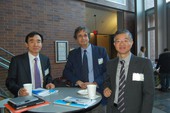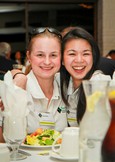Highlight
The 3rd International Symposium on LifeChips
Achievement/Results
On February 9-10, 2012, the NSF-funded LifeChips Integrative Graduate Education and Research Traineeship (IGERT) at the University of California, Irvine hosted the 3rd International Symposium on Lifechips. The theme was “Empowering human health with technology.” Over 120 academic investigators, industry leaders, students, and educators from California, the US, and international regions came together to discuss and review the latest trends and results of technology research for human health. The symposium focused on the uses of nano/micro-technology, communication and information technology for improving human health. The event was divided into three sessions: Miniaturized Diagnostics, Biomedical Microdevices, and Health and Wellness Systems. Each 180 minute session highlighted work performed by UC researchers as well as work performed internationally. In addition to presentation sessions (including Q&A), participants were invited to attend the poster session and networking mixer hosted by NSF funded LifeChips fellows. At the poster session, presenters shared their interdisciplinary research achievements and spoke with participants about collaboration ideas and opportunities. Conversations continued as attendees proceeded to the banquet dinner to hear keynote speaker Larry Smarr give an insightful presentation entitled, “Towards Digitally Enabled Genomic Medicine: the Patient of Tomorrow.” The symposium concluded with tours of UC Irvine’s Integrated Nanosystems Research Facility, Bio-Organic Nanofabrication Facility, and eHealth Collaboratory. The interdisciplinary nature of the LifeChips IGERT made it possible for engineers, life scientists, physicians, and industry leaders to come together to discuss progressive research in technology and human health.
Address Goals
This event highlighted UC’s leadership in applying technology to improve human health and it provided the opportunity for the INRF, BiON, and eHealth Collaboratory facilities to display their capabilities. It also brought together people from multiple disciplines, departments, and locations to discuss potential research projects. Overall, the event was a huge success and we believe that several new research collaborations will form as a direct result of this symposium.

































